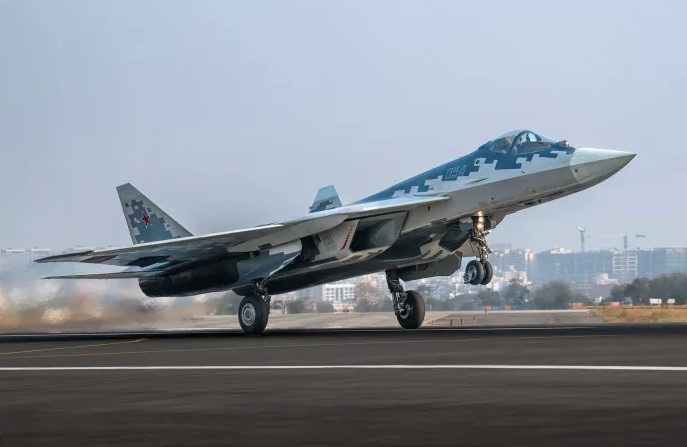Recent images circulating on social media have suggested, according to OSINT sources, that the Russian Aerospace Forces may have begun deploying their Su-57 stealth fighters for the very first time. If confirmed, this marks a major step for Russia, as OSINT analysis indicates the Russian Aerospace Forces appear to have integrated these advanced jets into a combat-ready regiment rather than keeping them in testing or training phases.
First Signs of Su-57 Deployment Through OSINT
The photographs, published through the messaging platform Telegram, showed two Su-57 fighters flying in formation. The accompanying caption read: “A Su-57 pilot looks at another Su-57 pilot who looks at another Su-57 pilot (…) These are the first combat pilots and the first Su-57s to enter service in a fighter regiment.” This short note sparked wide discussion among OSINT experts, who closely monitor such developments.
Analysts studying the visual evidence suggested that these fighters may belong to the 23rd Guards Fighter Aviation Regiment, a unit of the Russian Aerospace Forces. This regiment is based at Dzyomgi Air Base, located in the Russian Far East. If accurate, the deployment places the Su-57s roughly 186 miles from the border with China and about 413 miles from Japan’s northern island of Hokkaido.
⚔️ Two fighters, two doctrines: Su-57 built to strike hard, F-22 to vanish before it’s seen
However, despite the growing attention, the Russian government has not officially confirmed the location, timing, or details of the deployment. The photographs themselves lack clear geographic references, and the date of capture remains uncertain. As a result, the claims remain based on OSINT observations and expert assessments rather than direct confirmation.
OSINT Links to Russia’s Stealth Fleet Build-Up
The news of the possible deployment did not come as a complete surprise. OSINT reports earlier this year had already suggested that the Russian Aerospace Forces had received the first batch of Su-57s scheduled for 2025. This delivery was part of a gradual build-up of Russia’s fifth-generation fighter fleet.
In 2024, three separate batches of Su-57s were delivered to the service. These deliveries reportedly took place in September, November, and December, with each batch containing two or three aircraft. By adding the new arrivals of 2025, the fleet is slowly growing into a more significant force within Russia’s air defense system.
Crippling US Sanctions Endanger SU-57 Fighter Jet Program of Russia
The Su-57, sometimes described as Russia’s answer to U.S. stealth aircraft like the F-22 Raptor or the F-35 Lightning II, has long been in development. Russia tested initial models of the aircraft for years, but only recently the Aerospace Forces began moving it into operational service in larger numbers. OSINT observers highlight the aircraft’s stealth design, advanced radar systems, and its ability to carry both conventional and advanced missiles.
Analysts consider the reported stationing of Su-57s at Dzyomgi Air Base especially important because of the location. Komsomolsk-on-Amur, the nearest city, is a hub for Russia’s aircraft industry and has been central to the Su-57 production program. Stationing the fighters close to this region also provides logistical advantages for maintenance and support, according to OSINT findings.
Advanced Weapons and Strategic Importance
Adding further weight to the reports, just weeks before the images appeared, senior officials of the Russian Aerospace Forces discussed the ongoing modernization of the service. Lieutenant General Aleksandr Maksimtsev, Chief of the General Staff and First Deputy Commander-in-Chief of the Aerospace Forces, stated that Russia continues to receive modernized weapons systems under its state defense order. According to him, the number of Su-57s delivered each year is rising, along with the introduction of advanced air strike systems and hypersonic weapons.
The mention of hypersonic missiles that the Su-57 could potentially launch caught analysts’ attention. Although officials have not confirmed which weapons they plan, reports suggest two possibilities: a modified version of the Zircon cruise missile or the Kh-47M2 Kinzhal, which NATO calls the AS-24 Killjoy.
The air-launched version of the Zircon remains mostly unknown, as public details focus on its naval use. The Kinzhal is more familiar, already deployed by MiG-31K/I fighters and once considered for Tu-22 bombers. Reports suggest it may now be adapted for the Su-57, showing the aircraft’s potential to carry very fast, long-range weapons.
🇷🇺 Alaska in crosshairs: Russian Su-57 jets circle as U.S. relies on 1970s radar tech
The appearance of Su-57s in the Far East is notable due to the region’s geography. The jets are less than 200 miles from China and within reach of Japan’s Hokkaido, signaling that Russia is placing its most advanced fighters in a key location. However, without official confirmation, analysts continue to rely on photographs, aircraft markings, and OSINT assessments.
Despite the uncertainty, evidence shows that Su-57 stealth fighters are gradually entering Russia’s front-line units. New aircraft, advanced weapons, and their base near Komsomolsk-on-Amur highlight the importance of this step for the Russian Aerospace Forces.
